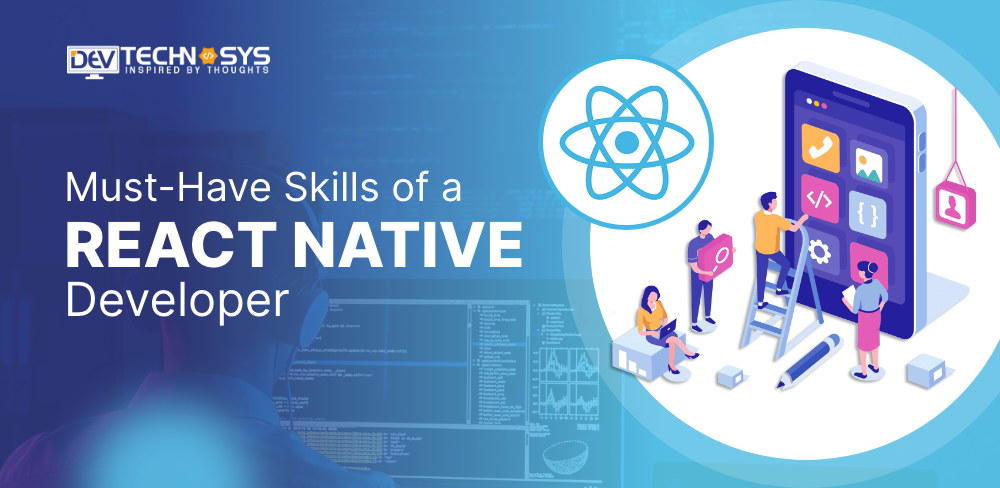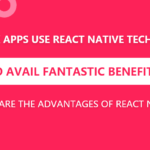Originally developed and released by Facebook in 2015, React Native has been identified as a fully open-source framework used by mobile app development company to build mobile apps on operating systems such as iOS apps.
React Native has been around for almost half a decade and we’ve had a lot of users who admire it for all its advantages. Cross-platform development, third-party library usage, faster production of applications, decreased complexity, etc.
React Native is an excellent framework for the development of hybrid mobile apps. For each operating system, the idea is mostly to compose the same code.
This saves a lot of time and strengthens control over a project. Although the devil is in the details, and in developing a React Native app for iOS and Android, there are some inconsistencies and limitations faced by React Native App Development company.
When Did It All Go Downhill?
Each framework carries its own set of drawbacks, and that there’s no exception to React Native. React Native is rife with a few performance issues, which have put off even the most seasoned of designers.
The major drawbacks of React Native were brought to the forefront when Airbnb notoriously transitioned from React Native to sunsetting the technology to capitalize its efforts on developing the Native app.
Firms such as Udacity quickly followed suit and migrated out of React Native, citing problems with performance and general upkeep. As with any other technology, React Native has its share of constraints.
Most of these problems are now being discussed by Facebook and the React Native community. Still, before you plan to make a quick unscheduled move to the development of React Native mobile apps, there are some that you should be cognizant of. It can prove to be good to have an idea of such misgivings.
Read More:- A Short Story About React Native
On April 8, 2020, the company launched the stable version of the React Native platform. The structure, followed by C++, Objective C++, Objective C, Java, and Python, is primarily developed using JavaScript.
Before you begin developing your mobile applications, identifying these drawbacks is incredibly important. In this blog post, we list some of React Native’s most common limitations.
This blog post is purely meant to draw the attention of development companies to the reaction-native problems they could perhaps face during the development of mobile applications.
We hope to help you avoid some very serious pain in your react native application development. Large-scale development companies hire React Native app developers to resolve this kind of issue.
Limitations Faced While Developing Mobile Application Using React Native
1. Requires Developers With Multiple Expertise
It is still addressed as a limitation as it requires expertise in three distinct platforms to create effective mobile applications using React Native. The developer may face a situation during the execution of the application where he needs to swap requests from native code to JavaScript code and vice versa.
The development company, therefore, needs to take care of the platforms on which the application is going to run in this scenario and therefore will need to have a thorough understanding of the development of Android mobile apps, iOS, along with React.js, i.e., the developing language used by the React Native Framework.
As stated clearly so far, react native development solutions require the developer to switch between Java, therefore, developers often need to maintain it according to the environment or platform, namely Android, iOS, and React.js, at the time of writing code, while they could have compiled the same code for all platforms.
2. Sometimes Requires Expertise Of Native Developers
It is intended for cross platform app development, but its operation often requires native app developers. This could happen because of the trend of Javascript applications that may have to run the native code.
Read More:- What to choose for cross platform app development? React Native Vs Xamarin
Generally, when you aim to create a heavyweight mobile app by responding to the native framework, this need occurs. If this is the scenario, you will need to erase some of the features and functionality to proceed with the react-native framework and thus make the application durable. You might need the help of native app developers to perform these tasks.
3. Does Not Support Some APIs
All the APIs are not supported by React Native. The most commonly used APIs are helpful, but some specific APIs are out of reach. Native modules must also be used for this purpose by mobile app development companies.
4. Requires A Developer’s Expertise
It is still addressed as a limitation since it requires expertise in three distinct platforms to create effective mobile applications using React Native.
While trying to execute the application, the programmer might face a situation where he needs to switch over the queries from Native code to the JavaScript code and vice-versa.
And thus in this predicament, the React Native App Development companies need to be aware of the platforms on which the prototype is going to run and therefore, along with React.js, iOS, the developing language used by the React Native Framework, would have to have a thorough understanding of Android mobile app development. Some help is available from tools like Expo, making it easier and more helpful to respond to react-native.
5. Complex User Interface
Although Javascript enables programmers to build fast and stable apps, it is much imperative to find resource-intensive apps on native building platforms, such as Java, Swift, and Objective-C.
Imagine that you are developing an application that needs a robust set of features, and at any point in time, there are indeed several things to consider running in the background.
If you ask any development team what framework they’d prefer to build one such app, there’s little chance that they’ll respond to React Native. Native iOS appears to offer far better alternatives for building dynamic graphics when contrasted to React Native.
Also, React Native does not offer assistance for these if you have to use the camera, touch ID, GPS, etc. for your app. To download these features, you must use the native framework.
6. Depends Mostly On Third-Party Libraries
React Native is being used solely for rendering reasons. It depends greatly on third-party libraries. This at the same moment, is good and bad.
A developer has the flexibility to choose libraries from third parties or it can be a pain at the very same time as well. Using a hybrid mobile application system architecture often requires external or third-party libraries to be integrated as the specific feature is not supported by the native platforms.
With each day, the use of third-party library resources and the dependence of developers on those libraries has increased. But with this dramatic rise, these library updates have become uncommon.
In direct contrast, constant updates on the React Native Framework are accessible and are being modified in very brief periodic gaps. As a consequence, third-party libraries are therefore obsolete and cannot be compatible with the current upgraded version of the React Native Framework.
In these instances, any mobile app development company can rely on React Native Assistance for these libraries and just anticipate the libraries to stay up-to-date.
7. Outdated Third-Party Libraries
In the category before, we talked about heavy reliance on third-party libraries. What you need to know, too is that updates to React Native is often more prevalent.
So when that takes place, libraries and services from third parties sometimes get outdated. You can expect it to continue updated or face app breaking problems depending on the community involvement for a specific library.
8. Quality Assurance Problems
Attributed to the prevalence of third-party libraries, external plug-ins in applications built using React Native frameworks, the performance of the form could deteriorate and make the applications more complicated.
Although it may sound surprising, React Native is still in beta, even so, used by top tech players. With package compatibility or debugging tools, your developers would perhaps come across different problems.
If your developers are not competent to React Native, this may negatively affect your advancement as they spend more time on troubleshooting.
Therefore, debugging such distributed algorithms could become a challenging task for a new developer. So make sure to hire React Native app developers who are experienced enough.
9. Loose Language
The React Framework uses traditional development platforms such as HTML, CSS, and JavaScript to define different layouts in your application.
It’s among the most common problems with React Native. Since this could be seen as an advantage because the platforms are easier to study and understand, some difficulties can be created by JavaScript involvement.
One of the drawbacks of Javascript is that it does not support differential type definition and therefore doesn’t allow its methods to pass parameters. The variables and methods, therefore, remain undefined and are independent to migrate as and when deemed necessary to any type.
10. Reusable Code Source
Whenever a platform or a framework is represented, it usually attempts to create an interface once and execute it on any platform, approaching a cross-platform one. But for every framework, this benefit doesn’t work correctly.
It may occur that due to compatibility problems with the use of a previous version of the external libraries, the mobile app development company needs to learn about deploying the application on that specific site.
Still not the whole code, but almost 75% remains reusable. The benefit is that the time taken for development is reduced, but again the solution is never a solution integrated with the platform, and the development company still needs to focus on it.
11. iOS Execution Is Not So Easy Using React Native
In React Native, if you consider testing your app utilizing testing services other than Apple’s testing tool, Testflight, you will find it frustrating. Because at the same time, you might just have to deal with issues of obtaining the required certificates and authorization profiles.
Nevertheless, except whenever you want to update your alpha version which can take up to 24 hours simply, the whole process is very painless and seamless on the Android platform.
12. Low Security
React Native is a library of JavaScript and also a free software framework, as development teams often meet the challenge of keeping the app safe. JavaScript is quite volatile, and some developers experience low levels of security as a result.
You ought to be extra careful when making applications that need additional layers of security, such as banking or finance applications. For such cases, prefer to hire dedicated developers.
Anything other than that, snippets of malicious code can pose a critical threat to the protection features of the app. This is why developers on React Native quite often avoid creating financial software.
13. Lack Of Custom Modules
React Native lacks some components even now, given its maturity. Others are insufficient, in turn. The probability would be that you won’t have any trouble with that, as most of the custom modules you want are accessible, well-documented, and functioning correctly.
It could happen, nevertheless, that you will have to construct your solution up from the ground or try to access an established one. You may end up with three codebases i.e. RN, Android, and iOS for a component rather than only one when building your custom modules. There can be disparities in behaviors and styles in each of those codebases. Luckily, those circumstances don’t often happen.
14. Inconvenient Debugging
A benefit of the React Native Framework is that it includes a built-in inspector to debug your apps. For an unintelligent web developer, debugging styles in React Native could be somewhat problematic as you can’t rely on a chrome debugger to modify the property of each element in a different manner.
Although you are offered a built-in inspector by React Native, it is quite a common fundamental at your disposal. If it develops and covers a lot of screens, you’d find it a bit annoying to debug styles, and comes the need to hire dedicated developers. To put it more simply, debugging styles in React Native can screw things up for you quite a bit.
But some restrictions also come with this built-in feature of the framework. For example, along with the built-in inspector, you might want a Chrome debugger to debug your code.
This creates a system dependence on the chrome debugger to modify every component and its features, which seems quite incredibly difficult.
15. Custom Design In Native Application
Another effect of having these layers of abstraction is that in application framework native languages like Java, Objective-C, or Swift, you will have to incorporate custom designs. This often decreases the advantage of keeping a hybrid platform and irks developers of mobile apps.
Conclusion
The benefits of RN include faster growth in smaller teams, the potential to reuse the codebase across various platforms, and the affordability of some convenient development tools.
Be aware that there are still some problems with the framework, but they’re all associated with technology immaturity and are probable to become less clunky in the future.
You have to take into consideration that some help from native Android and iOS developers still might be appropriate while working on larger or more complex projects.
Today, React Native is all about providing the cross platform app development framework, which means that if you create a React Native app, you are more likely to be exposed to the sector.
Now that’s plenty to reckon about! All in all, the future of React Native-it is still under very active development, and the community continues to grow.


























